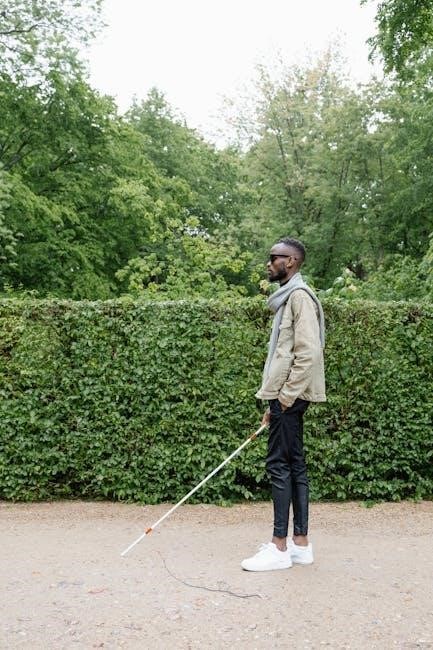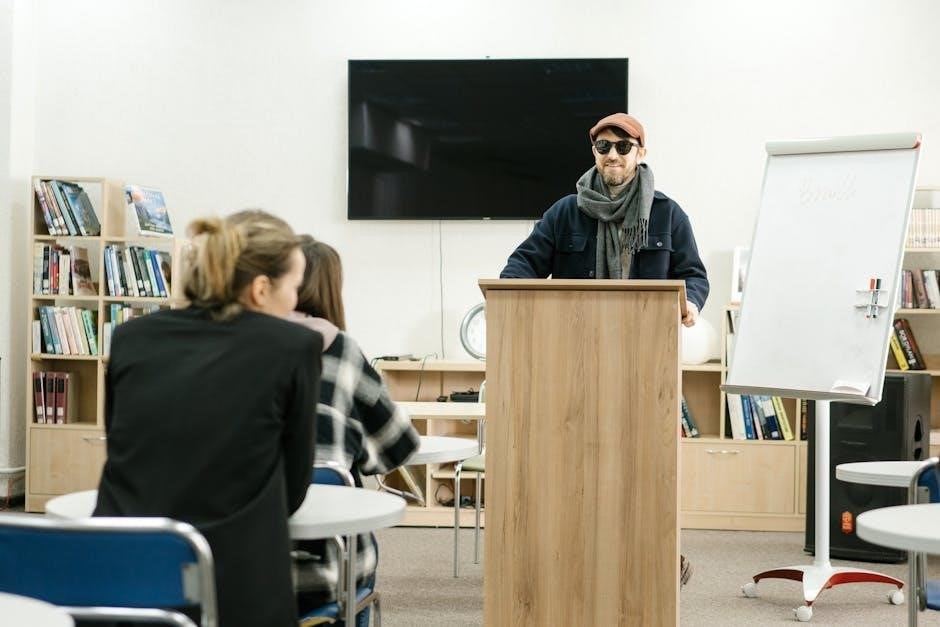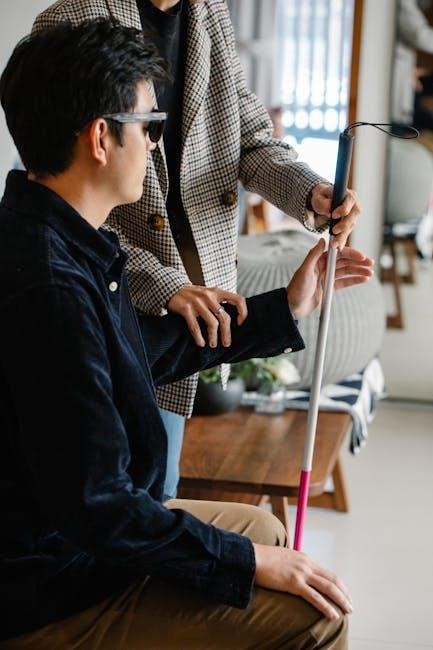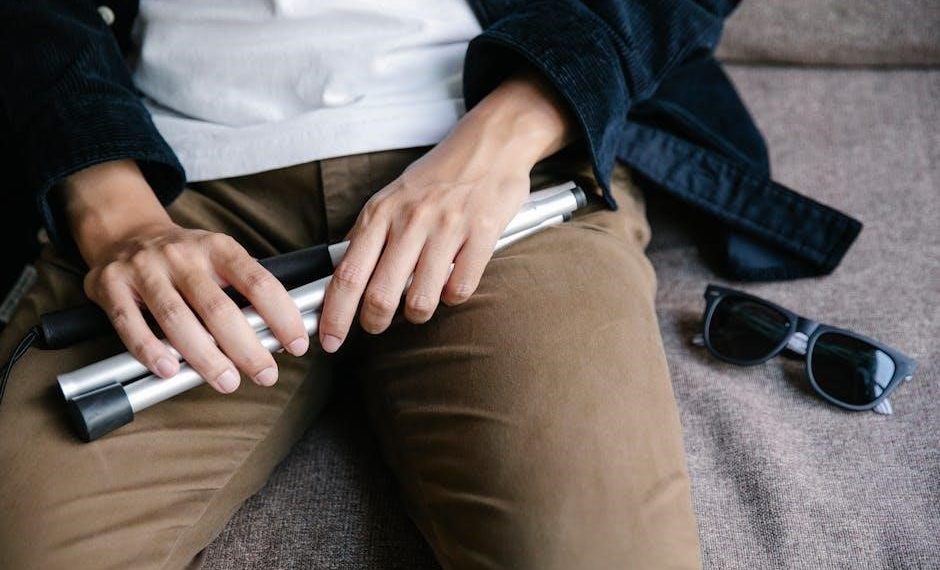guide for blind runners
What is Guide Running?
Guide running empowers visually impaired individuals to run independently with a sighted guide, fostering confidence, promoting an active lifestyle, and ensuring a safe experience through trust and teamwork.
What is Guide Running?
Guide running is a collaborative activity where a visually impaired runner pairs with a sighted guide to navigate routes safely. Guides provide verbal cues about terrain, obstacles, and directions, often using a tether for connectivity. This partnership fosters independence, builds trust, and enhances the runner’s confidence, enabling them to enjoy the physical and emotional benefits of running in a supportive environment tailored to their needs.
Importance of Guide Running for Blind Individuals
Guide running fosters independence and confidence, enabling visually impaired individuals to engage in physical activity safely. It promotes physical health, mental well-being, and social connections, breaking down barriers and empowering participants to achieve their fitness goals. This supportive partnership enhances overall quality of life, encouraging blind runners to embrace new challenges and thrive in an inclusive environment.
Benefits of Running for Blind Individuals
Running enhances physical fitness, mental resilience, and independence for blind individuals, fostering confidence and a sense of accomplishment while promoting overall well-being and social engagement.
Physical Health Benefits
Running significantly improves cardiovascular health, boosts endurance, and aids in weight management for blind individuals. It enhances muscle strength, flexibility, and overall physical fitness, contributing to a healthier lifestyle. Regular running also improves mobility and coordination, which are crucial for independence and confidence in daily activities. Engaging in this exercise supports long-term physical well-being and resilience, making it an invaluable activity for blind runners.
Mental and Emotional Well-being
Guide running fosters mental resilience and emotional strength, reducing stress and anxiety. It builds confidence, self-esteem, and a sense of accomplishment, empowering blind individuals to overcome challenges. The supportive relationship with a guide runner creates a bond of trust and camaraderie, enhancing emotional well-being and providing a sense of connection and purpose. Running also promotes mindfulness and joy, enriching overall mental health.
Social Benefits and Community Engagement
Guide running bridges social gaps, fostering meaningful connections between blind runners and their guides, creating a sense of community. Participation in group runs, like Parkruns, enhances social interaction, building friendships and shared experiences. It also promotes inclusivity, encouraging societal acceptance and understanding of visual impairments. The collective joy of running strengthens bonds, inspiring mutual support and a sense of belonging among participants.
Choosing the Right Guide Runner
A reliable guide runner should be trustworthy, communicate effectively, and demonstrate patience. They must also possess good physical fitness and a supportive attitude to ensure a safe experience.
Qualities to Look for in a Guide Runner
A guide runner should be trustworthy, experienced, and attentive. They must communicate clearly about obstacles, pace, and surroundings. Patience, empathy, and strong verbal cueing skills are essential. Physical fitness to match the runner’s ability and a positive, encouraging attitude are crucial. The guide should also be reliable and committed to building a strong, trusting partnership, ensuring the runner feels safe and confident during their journey.
How to Build Trust with Your Guide Runner
Building trust with your guide runner involves open communication, consistency, and mutual respect. Discuss preferences, pace, and boundaries early on. Regular practice helps establish a rhythm and understanding. Verbal cues and clear feedback foster reliability. Sharing experiences and goals strengthens the bond, ensuring a safe and enjoyable running partnership. Trust grows over time through reliability, empathy, and shared achievements.
Training involves building a consistent routine, incorporating assistive devices, and fostering clear communication with guide runners to ensure safety and confidence while running independently.
Building a Running Routine
Consistency is key to building a running routine for blind runners. Start with short, manageable sessions and gradually increase distance and intensity. Incorporate rest days to allow recovery and prevent injuries. Seek feedback from your guide runner to refine technique and pacing. Use assistive devices like GPS watches or apps to track progress. A well-structured routine fosters independence, confidence, and a lifelong love for running.

Training and Preparation for Blind Runners
Using Assistive Devices for Running
Assistive devices like GPS-enabled watches, fitness trackers, and specialized apps enhance safety and independence for blind runners. These tools provide real-time feedback on pace, distance, and navigation. Wearable devices with voice commands or vibrations help runners stay informed without relying solely on their guide. Additionally, apps designed for visually impaired athletes offer route mapping and obstacle detection, empowering runners to train confidently and effectively alongside their guides.
Safety Tips for Blind Runners
Blind runners should use GPS-enabled devices, apps with real-time feedback, and verbal cues from guides. Holding a tether ensures stability, while planning routes in familiar areas minimizes risks.
Staying Safe While Running
Blind runners can enhance safety by using GPS-enabled devices and apps with real-time feedback. Guides should provide clear verbal cues about obstacles and terrain. Holding a tether ensures stability and communication. Choosing familiar, well-lit routes with minimal obstacles reduces risks. Wearing reflective gear improves visibility to others. Planning routes in advance and informing someone about your running schedule can also add layers of safety. Using assistive tools like white canes or wearable devices further aids navigation and awareness while running.
Communication Strategies with Your Guide
Effective communication is key to a successful guide running experience. Blind runners and guides should establish clear verbal cues, such as “step up” or “slow down,” to navigate obstacles. Holding a tether ensures physical connection and stability. Pre-run briefings about the route and potential hazards help build trust. Regular check-ins during the run ensure both parties are comfortable and in sync, fostering a safe and enjoyable experience for both.
The Role of Technology in Guide Running
Technology enhances guide running through apps like Find a Guide, connecting runners with licensed guides, and wearable devices providing real-time feedback for safer, more independent experiences.
Apps and Tools for Blind Runners
Apps like Find a Guide connect visually impaired runners with licensed guides, while tools such as screen readers and GPS navigation apps provide real-time feedback, enhancing independence and safety during runs.
Wearable Devices for Enhanced Safety
Wearable devices, such as vibrating GPS trackers and smartwatches with tactile feedback, provide blind runners with critical real-time navigation and safety alerts, enabling them to run confidently and independently alongside their guides.

Finding a Guide Runner
Online databases and local running clubs connect visually impaired runners with trained guides, ensuring safe and enjoyable experiences through shared passion and mutual support.
Online Databases and Resources
Online platforms like “Find a Guide” offer databases to connect visually impaired runners with licensed guides. These resources allow users to search by location, experience, and availability, ensuring a perfect match. Many organizations, such as Guide Dogs for the Blind, provide comprehensive lists of trained guides and tips for building a successful partnership. These tools empower runners to find reliable support and stay active safely.
Local Running Clubs and Organizations
Local running clubs and organizations play a vital role in connecting blind runners with trained guides. Many clubs offer specialized programs, ensuring safe and enjoyable running experiences. These groups often provide structured training sessions and workshops, fostering a supportive community. By joining local clubs, blind runners can build confidence, improve fitness, and connect with like-minded individuals who share a passion for running and inclusivity.
Overcoming Challenges in Guide Running
Overcoming challenges in guide running involves building trust, improving communication, and refining techniques. These strategies enhance safety and confidence for blind runners, fostering a successful partnership.
Common Challenges Faced by Blind Runners
Blind runners often face challenges such as building trust with guides, navigating uneven terrain, and relying on verbal cues; Environmental obstacles, communication barriers, and the physical demands of running can also create difficulties; Additionally, the tether system and guide instructions must be precise to ensure safety and coordination, making adaptability and strong partnerships essential for success.
Strategies for Success
Success in guide running relies on consistent training, clear communication, and trust. Familiarizing oneself with routes, using verbal cues effectively, and incorporating assistive technologies can enhance safety and performance. Building a strong bond with the guide, staying positive, and celebrating small achievements also play crucial roles in overcoming challenges and achieving long-term success in guide running.
Success Stories of Blind Runners
Blind runners achieve remarkable feats with guide runners, completing marathons and setting records, inspiring others and proving resilience. These stories highlight the power of determination and community support.
Inspiring Achievements in Running
Blind runners, with the support of guide runners, have achieved extraordinary milestones. Many have completed marathons, set records, and inspired countless individuals. These achievements not only demonstrate physical prowess but also showcase mental resilience and determination. The stories of these runners highlight the transformative power of running and the impact of strong support systems.
Lessons Learned from Experienced Runners
Experienced runners emphasize the importance of trust, communication, and adaptability. Building a strong bond with your guide is crucial for a successful partnership. Consistency in training and using assistive devices can enhance safety and performance. Learning from challenges and staying persistent are key takeaways from those who have navigated the world of guide running with success and resilience.
Guide running opens doors to independence and confidence for blind individuals, proving that with the right support, running is accessible and fulfilling for all.
Final Thoughts on Guide Running
Guide running is a transformative experience that empowers blind individuals to embrace independence and joy through running. With the right guide, proper training, and trust, visually impaired runners can achieve their fitness goals and build confidence. The availability of resources like databases and supportive communities ensures accessibility for all. This partnership fosters not only physical health but also mental and emotional well-being, proving that running is truly for everyone.
Encouragement for Blind Runners
Running with a guide opens doors to independence, confidence, and joy. Trust in your guide, embrace the support, and celebrate every step. Whether you’re starting out or aiming for a marathon, remember that your potential is limitless. Surround yourself with supportive communities, use available resources, and never hesitate to take the first step. Running is for everyone, and your journey is just beginning.

Additional Resources
Explore organizations like “Find a Guide” and local running clubs to connect with licensed guide runners. Utilize apps and tools designed for visually impaired runners to enhance your experience.
Recommended Organizations and Websites
Organizations like “Find a Guide” and local running clubs offer databases to connect with licensed guide runners. Websites such as BlindRunners.org provide training resources and community support. These platforms are essential for finding guides, learning about adaptive running techniques, and joining inclusive running groups tailored for visually impaired individuals. Visit these sites to explore programs and tools that empower blind runners globally.
Further Reading and Support Groups
For further reading, explore books like Running Blind: The Inspiring Story of a Visionary Runner and online resources such as Adaptive Running Guides. Join support groups like the Blind Runners Community Forum to connect with others who share similar experiences. These platforms offer valuable insights, training tips, and encouragement, fostering a sense of belonging and empowerment among blind runners worldwide.
